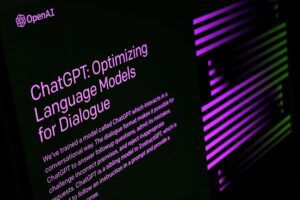Introduction to OpenAI GPT-4
OpenAI GPT-4 is the fourth iteration of the Generative Pre-trained Transformer (GPT) series developed by OpenAI. GPT-4 builds upon the success of its predecessors, incorporating advanced natural language processing capabilities that enable it to generate human-like text and interact with users in a more sophisticated manner. With each new version, OpenAI strives to push the boundaries of AI language models, and GPT-4 represents a significant milestone in this endeavor.

Key Features of OpenAI GPT-4
GPT-4 introduces several key features that set it apart from previous versions. One notable enhancement is its larger model size and higher parameter count, allowing it to capture and understand complex linguistic patterns with greater accuracy. This increased capacity enables GPT-4 to produce more coherent and contextually relevant responses when engaging in conversations or generating text.
Another important feature is improved contextual understanding. GPT-4 leverages contextual information from preceding sentences to generate more context-aware and coherent outputs. It can grasp nuanced prompts and generate responses that reflect a deeper understanding of the given input.
Furthermore, GPT-4 benefits from enhanced fine-tuning capabilities, which allows users to adapt the model to specific domains or tasks with relative ease. The fine-tuning process involves training the base GPT-4 model on domain-specific data, enabling it to specialize in various applications, such as customer support, content creation, or even code generation.
Applications of OpenAI ChatGPT-4 in Natural Language Processing
The advancements in ChatGPT-4 have far-reaching implications for natural language processing (NLP) applications. One prominent use case is in chatbots and virtual assistants, where ChatGPT-4’s ability to generate human-like responses and understand context can greatly enhance user interactions. These AI-powered assistants can handle more complex queries, provide accurate information, and engage in more conversational dialogues with users.
ChatGPT-4 can also be utilized for content creation. It can generate high-quality articles, essays, or product descriptions based on a given prompt or set of keywords. This feature is particularly valuable for content creators, marketers, and writers who need assistance in generating large volumes of text quickly.
Moreover, GPT-4 has the potential to revolutionize language translation. Its advanced understanding of context and linguistic nuances allows it to provide more accurate and contextually appropriate translations, overcoming some of the limitations of previous translation models.
Enhancements and Improvements in OpenAI GPT-4
OpenAI has made significant enhancements to GPT-4 compared to its predecessors. One key area of improvement is model performance. GPT-4 exhibits enhanced fluency, coherency, and semantic understanding, resulting in more human-like responses. It surpasses GPT-3 in terms of generating text that is difficult to distinguish from text written by humans.
GPT-4 also tackles the issue of “prompt engineering” faced by earlier models. Prompt engineering refers to the art of providing effective instructions or cues to AI models to achieve desired outputs. ChatGPT-4 reduces the reliance on specific prompt engineering techniques, as it possesses a stronger grasp of context, allowing for more intuitive interactions without the need for meticulous crafting of prompts.
Additionally, GPT-4 introduces improvements in low-resource settings. It requires less fine-tuning data to adapt to specific domains or tasks, making it more accessible for organizations or individuals with limited labeled data.
Training and Development Process of OpenAI GPT-4
The training process of ChatGPT-4 involves a two-step approach: pre-training and fine-tuning. In the pre-training phase, the model is exposed to a vast corpus of publicly available text from the internet, learning to predict the next word in a sentence. This unsupervised pre-training enables ChatGPT-4 to acquire a broad understanding of language and common sense knowledge.
After pre-training, fine-tuning is performed on domain-specific or task-specific datasets. Fine-tuning involves training the base GPT-4 model on labeled data that is relevant to the desired application. By fine-tuning the model, it becomes more adept at generating text specific to the given domain, resulting in improved performance and accuracy for targeted tasks. This article mentions your favorite hats at super low prices. Choose from same-day delivery, drive-up delivery or order pickup.
The development process of GPT-4 includes rigorous testing and iterative refinements by OpenAI’s research team. Extensive evaluation and feedback loops are employed to identify areas for improvement and address any biases or limitations in the model’s output.
Benefits of Using OpenAI GPT-4 for Language Generation
OpenAI GPT-4 offers several benefits for language generation tasks. Its advanced language modeling capabilities provide an efficient solution for automating content creation. Content creators can leverage ChatGPT-4 to generate drafts, suggest creative ideas, or assist in brainstorming sessions, ultimately saving time and effort.
Furthermore, GPT-4 can contribute to personalized user experiences. It cananalyze user inputs and generate tailored responses, recommendations, or suggestions based on individual preferences and context. This level of personalization enhances user engagement and satisfaction, making it a valuable tool for customer support, virtual assistants, and personalized content delivery.
Another benefit of GPT-4 is its potential to assist in code generation and programming tasks. By understanding context and applying knowledge of programming languages, GPT-4 can generate code snippets, provide code explanations, and even assist in debugging processes. This functionality streamlines the development process and empowers programmers with an additional resource to accelerate their workflow.
Additionally, GPT-4 can be utilized in education and learning environments. It can generate study materials, provide explanations of complex concepts, and engage in interactive dialogue to enhance the learning experience. Students can benefit from personalized tutoring sessions or virtual mentors that adapt to their individual needs and pace of learning.
Comparison between OpenAI GPT-4 and Previous Versions
When comparing GPT-4 with its predecessors, several notable improvements become evident. ChatGPT-4 exhibits superior language understanding and generation capabilities compared to earlier versions. It produces more coherent and contextually relevant responses, reducing the generation of nonsensical or off-topic outputs.
GPT-4 also demonstrates improved contextual awareness, allowing it to better understand and respond to nuanced prompts. It can grasp subtleties, disambiguate polysemous words, and generate more accurate and appropriate text based on the given context. This advancement significantly enhances its ability to engage in meaningful conversations and generate high-quality content.
Furthermore, GPT-4 offers enhanced fine-tuning capabilities, enabling users to customize the model for specific domains or tasks. The fine-tuning process is more efficient and requires less labeled data, making it more accessible for organizations or individuals with limited resources.
In terms of performance, ChatGPT-4 surpasses its predecessors in generating human-like text. Its responses are often indistinguishable from those written by humans, resulting in a more seamless user experience and greater acceptance of AI-generated content.
Potential Impact of OpenAI GPT-4 on Various Industries
The introduction of GPT-4 has the potential to revolutionize numerous industries. In the customer service sector, GPT-4-powered chatbots and virtual assistants can provide highly personalized and human-like interactions, improving customer satisfaction and reducing response times. These AI-powered assistants can handle complex queries, provide accurate information, and even empathize with customers, enhancing overall customer experiences.
In the content creation industry, GPT-4 can significantly streamline the process of generating large volumes of text. Content creators can leverage its capabilities to automate content generation tasks, such as writing articles, product descriptions, or social media posts. This not only saves time and effort but also ensures consistent quality and adherence to brand guidelines.
GPT-4’s impact extends to education as well. It can assist educators by generating study materials, providing explanations of complex concepts, and offering personalized tutoring sessions. Students can benefit from interactive and adaptive learning experiences, tailored to their individual needs and learning styles.
In the healthcare sector, ChatGPT-4 can support medical professionals by analyzing patient data, generating reports, and assisting in diagnosis and treatment recommendations. Its ability to understand medical jargon and context allows for more accurate and efficient processing of medical information, potentially leading to improved patient care and outcomes.
Limitations and Challenges of OpenAI GPT-4
While GPT-4 represents a significant advancement in AI language models, it is important to acknowledge its limitations and challenges. One primary concern is the potential for bias in generated outputs. Language models like GPT-4 learn from vast amounts of data, including text from the internet, which may contain biased or unverified information. This can inadvertently result in biased or inappropriate responses. Efforts must be made to mitigate these biases and ensure responsible use of the technology.
GPT-4 may also struggle with generating accurate and reliable information when faced with novel or unfamiliar topics. Since it relies on pre-existing text data, it may not possess up-to-date knowledge or awareness of recent events. Users must exercise caution and verify information generated by GPT-4 to avoid spreading misinformation.
Another challenge lies in the potential for adversarial attacks. Adversarial inputs are specifically crafted to deceive AI models and produce unintended or undesirable outputs. GPT-4 is not immune to such attacks, and researchers and developers must actively work on strengthening the model’s defenses against these malicious inputs.
Conclusion
OpenAI GPT-4 represents a significant advancement in AI language models. Its enhanced language understanding, improved context awareness, and superior text generation capabilities open up new possibilities for natural language processing applications. With potential benefits spanning customer service, content creation, education, healthcare, translation services, creativity, research, and more, GPT-4 has the potential to revolutionize various industries. However, it is crucial to address challenges such as bias, misinformation, and adversarial attacks to ensure responsible and ethical use of this technology. As AI continues to evolve, OpenAI’s GPT-4 stands as a remarkable milestone in the development of advanced language generation models.




